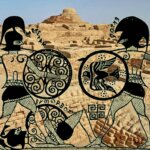History Of The Colloseum
The history of Rome’s Colosseum is lengthy and covers a great deal of land during its course. From the time it was used as a gladiator arena and saw staged hunts with thousands of wild animals until the current day, it has seen the Roman Empire develop to its greatest splendor, then start to decay, and eventually collapse.
72 AD –
The history of the endeavor to construct the Flavian Amphitheater begins with Emperor Vespasian, who was in command of the undertaking at the time. After all that the Roman people had been put through during the tyrannical dictatorship of Emperor Nero, Vespasian decided that constructing the Colosseum would be a wonderful way to demonstrate his gratitude and kindness to the Roman people.
80 AD –
Titus, son of Vespasian, bestows the name “Colosseum” upon the amphitheater that is more well known as the “Colosseum.” In addition to this, he gives the order to celebrate the inauguration of the amphitheater for a full one hundred days. The amphitheater is most often referred to as the Colosseum among common people. Domitian, Titus’ younger brother, and eventual successor would put the finishing touches on the construction project and carry it through to a complete completion in the year 83 AD.
217 –
The fire damages the building and completely destroys the hardwood floor on the upper level.
Mid 5th century,
The exact date of this event is unknown, but this is when the last records of gladiator fights in the Colosseum were made. Even so, wild animal hunts continued in the Colosseum for a long time after this.
Late 6th century –
The Colosseum is no longer used to entertain Romans because it is no longer being used as an amphitheater, which was its original purpose. Around this time, a church was added to the building, the arena floor was turned into a cemetery, and the vaulted vaults that make up the building’s walls below the seats were turned into homes and workshops. Around this time, all of these changes took place.
Around the 12th century,
The building was taken over by the powerful Roman aristocratic family known as the Frangipani family at the time. Once they owned it, they turned it into a walled castle.
The earthquake causes a lot of damage to the building, including the collapse of a section of the building’s exterior walls. The damage is still visible today because there are parts of the building that are missing.
Between the 14th century and the 18th century –
Over time, the Colosseum’s condition keeps getting worse as its parts are taken apart and used in other construction projects around Rome. The iron clamps that held the stones in place are being taken off so that they can be melted down and used for something else. Also, the stones that were used to build the building’s frame have been saved and are being used to build other buildings all over the city. Some of the marble that was later used to decorate the outside of Saint Peter’s Basilica was used inside the cathedral while it was being built.
1749 –
Following many years of gradual degradation, Pope Benedict XIV proclaimed the structure to be holy and issued an order that it be maintained in excellent condition so that other generations may reap the benefits of it. He does this because he believes that the arena acquired sanctity as a result of the deaths of Christian martyrs who fought there. He acts in this manner because he is certain that the arena has become a sacred location. On the other hand, this assertion is not supported by a significant amount of data from times gone by.
Throughout the 19th and 20th centuries,
Throughout its history, the Colosseum has been fixed up by different Popes, governments, and the city of Rome.
In the years between 2013 and 2016,
The Colosseum, which is a Roman amphitheater, is going through a big project to fix it. The outside of the whole building is carefully cleaned to get rid of the dirt and soot that had built up over the years from Roman traffic. This makes the building look as good as new.
Today –
More than four million people visit Rome every year to see the Colosseum. Many people all over the world think of it as one of the most well-known and easy-to-recognize buildings in the world. It is also the place where most tourists go when they are in Italy. It was finished in the year 80 AD, but it was still called the Flavian Amphitheater at that time. It is now 1,937 years old, making it one of the oldest and best-preserved man-made structures in the world.
People have theorized that the sand dunes of the arena were home to the deaths of up to 400,000 humans and 1 million wild creatures representing a vast array of species.

The Colloseum























Leave a Reply